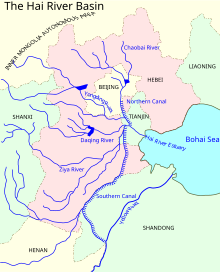Hai River
| Hai River Hai He | |
|---|---|
 Hai River in Tianjin | |
 Hai River basin | |
| Native name | 海河 (Chinese) |
| Location | |
| Country | China |
| State | Tianjin, Hebei, Beijing, Henan, Inner Mongolia, Shanxi, Shandong |
| Physical characteristics | |
| Source | Taihang Mountains、Yan Mountains |
| Mouth | Bohai Sea |
| Length | 1,329 km (826 mi) |
| Basin size | 318,200 km2 (122,900 sq mi) |
| Discharge | |
| • average | 717 m3/s (25,300 cu ft/s) |
| Hai River | |
|---|---|
Hanyu Pinyin | Bái Hé |
The Hai River (海河, lit. "Sea River"),
.During the Song dynasty, the main stream of the Hai River was called the lower section of the Jie River. In the Jin and Yuan dynasties, it was renamed as Zhígǔ River (直沽河, lit. “Straight Gu River") and Dàgǚ River (大沽河, lit. “Great Gu River") respectively. The name Hai River first appeared towards the end of the Ming dynasty.[1]
The Hai River at
At Tianjin, through the Grand Canal, the Hai connects with the
The Hai River is 1,329 kilometers (826 mi) long measured from the longest tributary. However, the Hai River is only around 70 kilometers (43 mi) from Tianjin to its estuary. Its basin has an area of approximately 319,000 km2 (123,000 sq mi).
History

On 20 May 1858, the Pei-ho, as it was then known, was the scene of an invasion by Anglo-French forces during the Second Opium War whereby the Taku Forts were captured.[2]
In 1863 seagoing ships could reach the head of navigation at
Like the Yellow River, the Hai is exceedingly muddy because of the powdery soil through which it flows. The silt carried by the water deposits in the lower reaches, sometimes causing flooding. The waters from the five major tributaries only have one shallow outlet to the sea, which makes such floods stronger. Because China's capital (and second largest city), Beijing, and the third largest city, Tianjin, both lie in the Hai He Basin, Hai He floods cause a significant loss. To alleviate flooding, reservoirs have been built and artificial channels dug to divert excess water directly into the sea. For example, the Chaobai River is diverted to the Chaobai Xin River and no longer joins with the Northern Canal.
Due to industrial and urban development in the Hai He Basin, the volume of water flow has greatly decreased. Many smaller tributaries and some of the major tributaries are dry for most of the year. With reduced water flow, water pollution worsens. The water shortage in the Hai He basin is expected to be alleviated by the
See also
References
- ^ 王国春, 海河志编纂委员会 (1997). 海河志: 第一卷 [Hai River Annals: Volume One] (in Chinese). 中国水利水电出版社. p. 128.
- ^ "List of Casualties". Bulletins and Other State Intelligence for the Year 1858. Part 3. London: Harrison and Sons: 2869–2874. 1860.
- ^ Alexander Michie,The Siberian Overland Route from Peking to Petersburg, 1864
- G.P.O.p. 533. Retrieved February 19, 2011.(Document (United States. War Dept.))(Original from Harvard University)
- )(Issue 33 of Publication (United States. Adjutant-General's Office. Military Information Division) Issue 143 of Document, United States War Dept Issue 33 of Publication, United States Adjutant-General's Office)
- ISBN 9780823901456. Retrieved February 19, 2011.(Original from the University of Wisconsin - Madison)
- )(Issue 143 of Document (United States. War Dept.))(Original from the New York Public Library)
Bibliography
 This article incorporates text from Publication, Issue 33 Document (United States. War Dept.), by United States. Adjutant-General's Office. Military Information Division, a publication from 1901, now in the public domain in the United States.
This article incorporates text from Publication, Issue 33 Document (United States. War Dept.), by United States. Adjutant-General's Office. Military Information Division, a publication from 1901, now in the public domain in the United States. This article incorporates text from Reports on military operations in South Africa and China. July, 1901, by United States. Adjutant-General's Office. Military Information Division, Stephen L'H. Slocum, Carl Reichmann, Adna Romanga Chaffee, a publication from 1901, now in the public domain in the United States.
This article incorporates text from Reports on military operations in South Africa and China. July, 1901, by United States. Adjutant-General's Office. Military Information Division, Stephen L'H. Slocum, Carl Reichmann, Adna Romanga Chaffee, a publication from 1901, now in the public domain in the United States. This article incorporates text from Reports on military operations in South Africa and China, by Stephan L'H. Slocum, Carl Reichmann, Adna Romanza Chaffee, United States. Adjutant-General's Office. Military Information Division, a publication from 1901, now in the public domain in the United States.
This article incorporates text from Reports on military operations in South Africa and China, by Stephan L'H. Slocum, Carl Reichmann, Adna Romanza Chaffee, United States. Adjutant-General's Office. Military Information Division, a publication from 1901, now in the public domain in the United States.
Further reading
- Domagalski, J.L., et al. (2001). Comparative water-quality assessment of the Hai He River basin in the People's Republic of China and three similar basins in the United States [U.S. Geological Survey Professional Paper 1647]. Reston, VA: U.S. Department of the Interior, U.S. Geological Survey.
